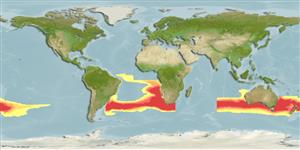>
Myctophiformes (Lanternfishes) >
Myctophidae (Lanternfishes) > Diaphinae
Etymology: Diaphus: Greek, dis, dia = through + Greek, physa, phyo = to beget, to have as offspring (Ref. 45335).
Environment: milieu / climate zone / depth range / distribution range
Ecología
marino batipelágico; oceanodromo (Ref. 51243); rango de profundidad ? - 250 m (Ref. 36731). Deep-water
Circumglobal distribution in the region of the Subtropical Convergence, but may be absent over the region 115°W to the coast of Chile. Eastern Atlantic: known from the southern boundary limit, 23°S to 21°S but probably farther to the north in the Benguela Upwelling Region.
Southwest Atlantic: between 32°S and 46°S (Ref. 47377).
Length at first maturity / Tamaño / Peso / Age
Maturity: Lm ?, range 4 - ? cm
Max length : 5.4 cm SL macho / no sexado; (Ref. 4479)
Short description
Claves de identificación | Morfología | Morfometría
Espinas dorsales (total) : 0; Radios blandos dorsales (total) : 13 - 15; Espinas anales: 0; Radios blandos anales: 12 - 14.
Oceanic and mesopelagic (Ref. 4066). Taken as prey by hakes, kingklip and Cape horse mackerel (Ref. 36731). Found in the upper 250 m at night. Spawns in spring-early summer.
Reach sexual maturity at a length of 3,6 cm (Ref. 47377).
Life cycle and mating behavior
Maturities | Reproducción | Spawnings | Egg(s) | Fecundities | Larva
Hulley, P.A., 1990. Myctophidae. p. 398-467. In J.C. Quero, J.C. Hureau, C. Karrer, A. Post and L. Saldanha (eds.) Check-list of the fishes of the eastern tropical Atlantic (CLOFETA). JNICT, Lisbon; SEI; Paris; and UNESCO, Paris. Vol. 1. (Ref. 4479)
IUCN Red List Status (Ref. 130435)
Threat to humans
Harmless
Human uses
Herramientas
Special reports
Download XML
Fuentes de Internet
Estimates based on models
Preferred temperature (Ref.
123201): 11.8 - 18.8, mean 15.7 °C (based on 7 cells).
Phylogenetic diversity index (Ref.
82804): PD
50 = 0.5000 [Uniqueness, from 0.5 = low to 2.0 = high].
Bayesian length-weight: a=0.00759 (0.00332 - 0.01733), b=3.02 (2.83 - 3.21), in cm total length, based on LWR estimates for this Genus-body shape (Ref.
93245).
Nivel trófico (Ref.
69278): 3.0 ±0.00 se; based on food items.
Resiliencia (Ref.
120179): Alto, población duplicada en un tiempo mínimo inferior a 15 meses (Preliminary K or Fecundity.).
Fishing Vulnerability (Ref.
59153): Low vulnerability (10 of 100).
